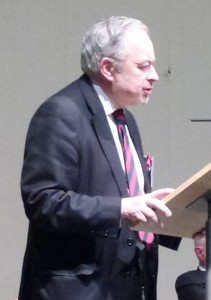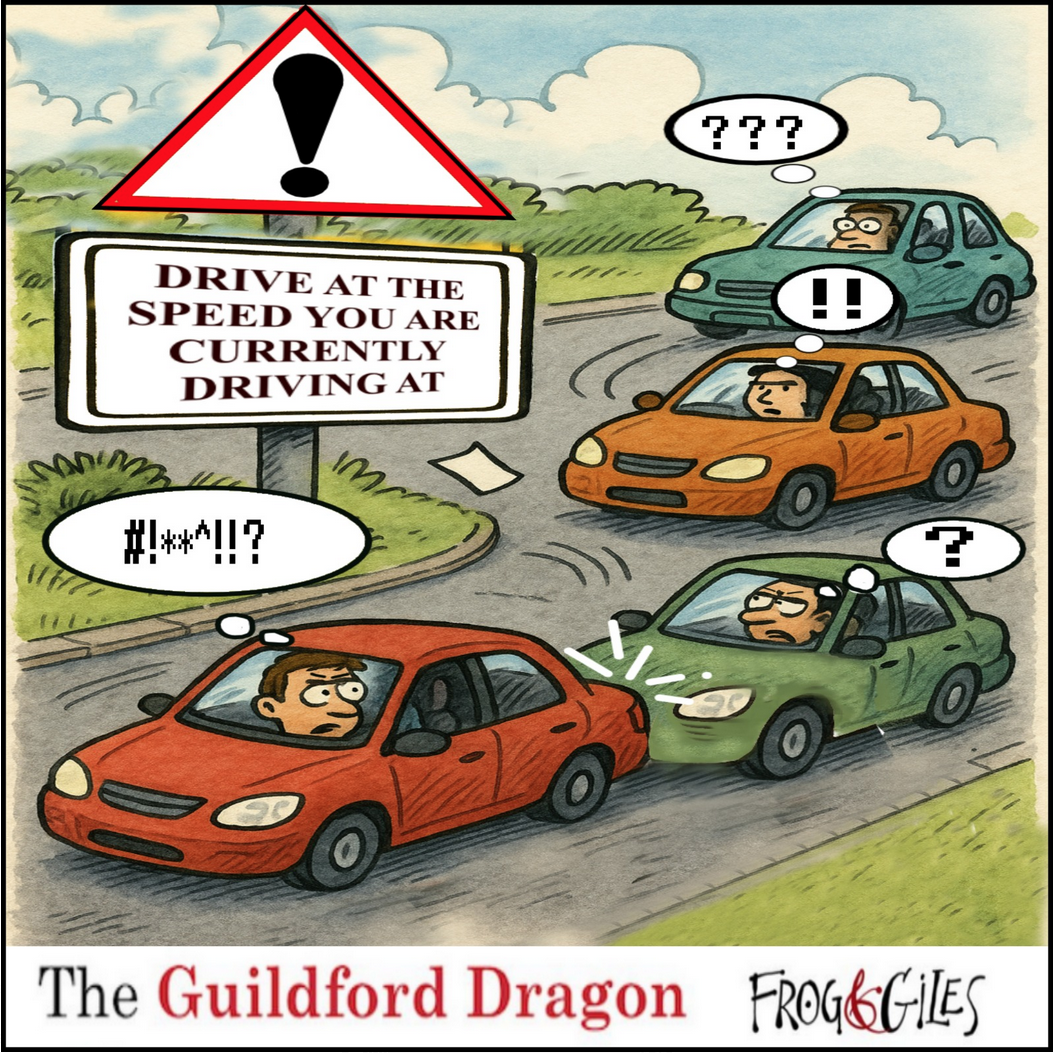 Abraham Lincoln
If given the truth, the people can be depended upon to meet any national crisis...
Abraham Lincoln
If given the truth, the people can be depended upon to meet any national crisis...
 Guildford news...
for Guildford people, brought to you by Guildford reporters - Guildford's own news service
Guildford news...
for Guildford people, brought to you by Guildford reporters - Guildford's own news service
Dragon Interview: John Rigg – Guildford Vision Group
Published on: 18 Aug, 2016
Updated on: 23 Aug, 2016
It was a legal challenge from the Guildford Vision Group (GVG) that caused the demise of the 2012 version of the Local Plan for Guildford and the takeover, as council leader, by Stephen Mansbridge from Tony Rooth.
Relations between the group and the council gradually improved and eventually Guildford Borough Council (GBC) seemed to accept the need, as put forward by GVG for “masterplanning” for the town centre.
Now, some are disappointed that the Allies & Morrison Masterplan, widely welcomed when it was published, is not more evident in the latest version of the Local Plan.
The Dragon decided it was time to catch up with GVG chairman, John Rigg and get his view of the situation. Interview conducted by Martin Giles.
GVG and GBC seemed to have quite a good working relationship when the Masterplans were published but now you are quite critical about the Local Plan, labelling it “sad”. What has gone wrong?
The Local Plan does not pick up the town centre in a way we would have liked. The town centre is a key piece of infrastructure for the borough. We would have liked a clearer commitment in the Local Plan to bring forward the town centre plan early in the Local Plan period. This would be as part of the infrastructure required to support proposed housing and employment allocations.
We do have a largely positive relationship with key officers and councillors but do not agree on everything. We are keen to keep working with them for a better town. We can only see good benefits emerging from collaboration.
As voting, council tax-paying residents, surely we’re all in this together with our councillors and officers? So let’s work together in a positive, progressive manner.
What would you like to see in the redevelopment of North Street?
A viable development of retail and residential uses; a credit to the town for many years to come. This will require great attention to detail – particularly in the public places and spaces – and must not dominate the skyline or adversely impact the heritage, character, setting and context of the town.
In short, a healthy retail/residential mix, great street scene, good design in keeping with the setting and a public realm that links synergistically with adjoining features such as a revitalised riverside.
Above all, it must complement the town centre plan and should benefit from GVG’s proposed traffic solution to bring forward an active street scene and pedestrian priority zone in Bridge Street and Onslow Street.
Won’t commercialism simply hold sway and dictate what we get?
There has to be a commercial value in development, but that does not mean everything else has to go out of the window. We would usually advocate a public design competition. This is unlikely to happen but we need the architects to feel they have to win over the community and produce architecture fit for our county town. This should not be mutually exclusive with commercial success.

John Rigg addressees one of the public meetings the Guildford Vision Group has held on town planning issues.
Do you think there should be more specific public consultation on the town centre proposals?
It is always important to consult. It is vital that consultation is inclusive, not pre-determined. It has to be transparent and fair – and it must lead somewhere. The absence of the town centre plans from the Local Plan is perhaps understandable as a matter of law because the evidence base is not yet complete. But it is not understandable to all those who responded to Allies & Morrison and GBC’s consultations on the Masterplan. We fear fewer people will believe in it becoming a reality because they see no progress, even though we understand the council continues to work on it.
If there is to be an “area action plan” (AAP) post Local Plan adoption then that should provide the opportunity for greater and meaningful public consultation. We hope that in the meantime GBC will engage with us collaboratively as the AAP is worked up.
Why do you favour a new bridge as opposed to town centre road tunnels?
We think that a new east-west crossing is an essential piece of infrastructure if Guildford is to survive. We believe that bridges, while expensive, are cheaper.
Bridges and tunnels are large pieces of infrastructure. Tunnels typically will use more land at each end and generally are not very attractive in an urban setting. Bridges require ramps and structures but they can be built, with careful use of levels, to minimise the impact of the associated infrastructure. And they can be things of real beauty. How many towns and cities are enhanced by iconic bridges such as Calatrava’s masterpiece of engineering and design over the Liffey in Dublin? It’s a swing bridge of almost identical length to that which we propose over the railway.
The bridges can be constructed alongside the railway and river and swung into place. The crossing can be delivered in manageable phases. A tunnel would have to be delivered in one fell swoop, an almost impossible task given Guildford’s layout and topography.
What would you like to see proposed for the railway station. Do you think the station should reflect the town’s historic character?
The station itself needs to be a modern transport hub and interchange. It is key transportation infrastructure and should link to other surface transport.
There is likely to be an expansion of the station itself to provide airport links, greater capacity of Portsmouth line trains and suburban trains as recommended in the the Wessex Plan. Development of the station forecourt should not be allowed to stymie this.
Buses should interconnect with the trains and will need reliable timetabling to succeed – traffic management is a key part of that process, and GVG is clear that its crossing will help with that.
Development of the station area should not be allowed to frustrate the provision of a traffic solution.
Finally, the development as proposed was brutish and so out of keeping with the county town vernacular we have cherished over the years. We certainly don’t want to see “anytown” architecture.
It was stated in a recent GVG newsletter that, when it came to town planning, Guildford was in the “Last Chance Saloon”. What if GBC misses the last chance?
 Our main advantage at the moment is that nothing much has happened for 40 years and there are sites available prior to development. If these are developed piecemeal, we will lose every opportunity to fix things as inexpensively as possible. The town will either be strangled by congestion and die, or there will need to be a much more expensive and intrusive solution in the next several years.
Our main advantage at the moment is that nothing much has happened for 40 years and there are sites available prior to development. If these are developed piecemeal, we will lose every opportunity to fix things as inexpensively as possible. The town will either be strangled by congestion and die, or there will need to be a much more expensive and intrusive solution in the next several years.
Why has postwar architecture in Guildford been, in general, so uninspiring?
Guildford began this by turning its back on the river after the 1968 floods and by embracing 1960s architecture at the expense of some fine Georgian buildings and our landscape setting.
Since then we have gone through a phase where it seems what is good for Milton Keynes is aspirational for Guildford. But what is wrong with well-executed “pastiche”?
We can see a successful example of this at Richmond upon Thames waterside where the new buildings echo the past but are functionally forward-looking.
Guildford has now delegated design in the planning process to the South East Design Panel – there is no attempt to make Guildford’s future echo its past and this is a crying shame. We must have the confidence to preserve and enhance our character as we grow.
Do you accept the accuracy of GBC’s 1.6% of green belt for development figure and do you think green belt development is necessary?
These sorts of figures are a matter of fact – right or wrong. The Guildford Society, for example, has made great efforts to spell out the figures – Annex 6 of its reply to the 2014 Local Plan consultation is a good starting point.
There are several key truths here:
- we have failed to meet our existing housing target for several years now;
- greenfield sites are typically easier to develop than brownfield, especially town centre brownfield;
- one key purpose of the green belt is to promote urban regeneration, in other words, by limiting land for development where it is easy, the difficult sites can come forward;
- the nature of our town centre sites – with floodplain issues and delays in bringing land forward with acceptable schemes – is such that we need quite some time to bring them forward. – consider the Woodbridge Meadows area, which will probably take 10 years before we can even make any serious inroads into the housing shortfall;
- whatever the housing need number actually is, and whatever the capacity of our town centre sites, we will need to use some green field sites to deliver enough housing;
- the debate about percentages of green belt is perhaps unhelpful – 89% of the borough is in the green belt; 91% of the borough is either green and blue areas or domestic gardens; less than 1.6% is housing footprint; 3% is roads.
This debate is for others, and if urban regeneration such as GVG has been pressing for had been implemented 10 to 15 years ago, there would now be less pressure to develop in the green belt.
What do you mean by saying the GVG is in favour of growth – in the spectrum zero to the SHMA target where is GVG?
We have always said we’re in favour of growth to confound those who might otherwise see us as anti-progress or NIMBYs. We believe any entity – be it family, business or community – cannot stand still. There has been little substantial development in the town centre over the past 30 years. What little there has been has been dire.
We can’t live in a vacuum. There are towns like Ludlow where the historic grain of the town has been less spoilt over the years – because it is just too far from Birmingham for the pressures of growth to reach it. Guildford is different, as we cannot unmake decisions of the past such as building a railway between London and Guildford, establishing a university in the town and so many other decisions in between.
We need growth to help fix infrastructure deficits that have accumulated over several decades.
The inconvenient truth is that we will probably have to accept growth whether we like it or not. In that case, we would rather it were a force for good for Guildford, rather than getting growth without the infrastructure. That would ruin the town, our economy and everything we are all working in our different ways to try to protect.

Click on cartoon for Dragon story: Public Asked for Views on SCC’s Proposal for Reduced Speed Limits



Recent Articles
- Have You Seen Missing Scarlet-Rose?
- Guildford’s MP Cuts the Ribbon at Merrow Post Office Opening
- Letter: Recreational Rowing Might Be the Answer
- A281 Closure – Additional Works To Take Advantage of Road Closure
- Breast Screening Unit Comes To RHS Wisley
- Final Phase of Deepcut Redevelopment Approved
- GuilFest Returns to Stoke Park with Global Names and Local Soul
- Exercise May Aid Body’s Immune Response Against Cancer, Pilot Study Finds
- Letter: How Surveys of Public Opinion Should Be Organised
- Updated: Catapult Attacks, Shoplifting and Graffiti – the ASB Problem That Ash Is Facing


Search in Site
Media Gallery
Dragon Interview: Local Artist Leaves Her Mark At One of England’s Most Historic Buildings
January 21, 2023 / No Comment / Read MoreDragon Interview: Lib Dem Planning Chair: ‘Current Policy Doesn’t Work for Local People’
January 19, 2023 / No Comment / Read MoreA3 Tunnel in Guildford ‘Necessary’ for New Homes, Says Guildford’s MP
January 10, 2023 / No Comment / Read More‘Madness’ for London Road Scheme to Go Ahead Against ‘Huge Opposition’, Says SCC Leader
January 6, 2023 / No Comment / Read MoreCouncillor’s Son Starts Campaign for More Consultation on North Street Plan
December 30, 2022 / No Comment / Read MoreCounty Council Climbs Down Over London Road Works – Further ‘Engagement’ Period Announced
December 14, 2022 / No Comment / Read MoreDragon Interview: GBC Reaction to the Government’s Expected Decision to Relax Housing Targets
December 7, 2022 / No Comment / Read MoreHow Can Our Town Centre Businesses Recover? Watch the Shop Front Debate
May 18, 2020 / No Comment / Read More







Recent Comments